ROBERT MARTIN: TOO GOOD AN AUTHOR TO BE
FORGOTTEN, by Jim Felton
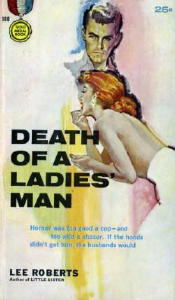 Often it is easy to
understand how some once-popular writers have been forgotten: just read
some of their work. Or try to read it. At times it is hard
to understand how they could ever have been popular. Better to
let Unsolved Mysteries take a
shot at some of these cases – and for
some of the “remembered” writers as well. Inevitably, though,
some worthy writers become forgotten, pushed from memory when there is
nothing new forthcoming for previously loyal readers, overwhelmed by
the unending flow of books by other writers. One author quite
worthy of being remembered is Robert Martin (1908-1976). And not
merely because he lived down the street from me when I was a kid.
Often it is easy to
understand how some once-popular writers have been forgotten: just read
some of their work. Or try to read it. At times it is hard
to understand how they could ever have been popular. Better to
let Unsolved Mysteries take a
shot at some of these cases – and for
some of the “remembered” writers as well. Inevitably, though,
some worthy writers become forgotten, pushed from memory when there is
nothing new forthcoming for previously loyal readers, overwhelmed by
the unending flow of books by other writers. One author quite
worthy of being remembered is Robert Martin (1908-1976). And not
merely because he lived down the street from me when I was a kid.By all appearances, Bob Martin was a very popular writer in his day. As far as I know he published only mysteries, mostly featuring a private detective as the leading character. Larry Estep of Pulpgen fame provided me a list of some 51 pulp stories plus reprints – and there were a few more to discover. Martin’s name appears thirty-seven times on the covers of U.S. magazines with his stories (plus one issue without a story by him). Martin easily made the transition into the hardcover and paperback novel markets, eventually publishing 22 novels. Starting off slowly, Martin’s pulp career went back to 1936 with “A Case for the Morgue” appearing in Scarlet Gang Smashers. A total of three stories appeared in Double Action Gang Magazine in 1938 and 1939. Discounting the 1942 reprinting of his story “Getaway Double-cross” by the Canadian Private Detective pulp, we don’t find him again until 1944 when the first of his four stories published in Mammoth Detective appeared when Howard Browne had taken over. Martin broke into Dime Detective in 1945 with the first of his 23 that would appear in that magazine, and he also made an appearance in Thrilling Detective that year. He would break into Black Mask the following year for the first of eight stories he had published there. A story by Robert Martin, “Passage a Tabac,” appeared in the French-Canadian pulp Loup Noir, another Popular Publications title, but it has not been confirmed that this is “our” Robert Martin. I have a copy but don’t read French. In contrast to that slow start, 1947 would see seven stories published, nine in 1948, thirteen in 1949, and nine in 1950. Most of these were in titles produced by Popular Publications. I suspect this may have been due in part to the fact his agent was the fabled Joseph T. Shaw. During that time frame. Martin’s name would often be featured on the cover, even as mentioned earlier, once when no story of his appeared in that issue (Dime Detective, January 1949). 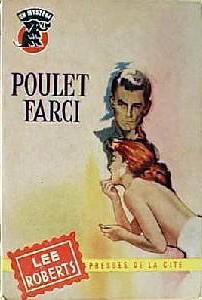 Just two of his short stories saw print in both 1951 and 1952, and only single stories appeared in 1954 and 1955. This last short story was published in the first issue of the short-lived Justice magazine. Beside the Canadian reprints, at least eight short stories were reprinted in Great Britain, three in Australia, two in Finland, and two in Sweden. As far as I have been able to discover, Robert Martin did not write for the pulp magazines under any pseudonyms, nor in other genres. Monte Herridge has turned up a reference to a story by Rob Martin in Prison Life Stories in 1935, but I would have to see the story before making any comment. Martin graduated from high school in 1927, so it is possible for other early stories to be uncovered. It is not clear to me how he went from being a sporadically published writer to becoming a regular almost overnight. Perhaps it was a matter of getting someone’s attention when fresh writers were sought. I have read his 1936 story “Midnight Call,” and it is well-written crime and suspense tale. After one of the bank robbers is shot during a hold-up, they pick a doctor out of the phone book to treat the wounded gang member. The doctor is taken to the hideout and told he will be killed if he does not save the wounded man’s life. As the short story market was drying up, Martin turned to the longer novel form, a natural progression, since a number of his pulp stories were novelettes or called novel-length. Between 1951 and 1965, Martin published fourteen novels as Robert Martin and eight as Lee Roberts, a pseudonym which incorporated his middle name. His books were part of the Red Badge Detective mystery series published by Dodd, Mead. As many writers did, he relied on his body of published pulp stories for characters and plots. In both 1955 and 1957 he published three novels, and two novels per year five other times. Three novels were reprinted in Detective Book Club editions. Toward the end of his career, his novels began to appear as paperback originals, and eventually he found no publisher for his final stories. Martin’s novels were read around the world. Canadian editions exist for several titles in paperback. There were British editions in both hardback and paperback. In fact Martin’s last four novels were published first in Great Britain many years before the American editions. All were translated into German and went through several editions in paperback with a few title also coming out in hardback. At least seventeen of the novels appeared in Italian translations. There were French editions for seven of the novels, and Swedish editions of two. Spanish and Japanese translations may also exist. He even made it into television. His novel The Widow and the Web was the basis for the episode by the same name on 77 Sunset Strip and is available on video tape. One of his novels is said to have been used for Surfside 6, another series by the same producers, but this remains to be verified. For the most part his main characters are either private detectives or small town family doctors. In the pulps he used Jim Bennett or Lee Fiske as PI’s, as well as a couple of others; Clinton Colby usually appeared as his doctor. Jim Bennett was his most well developed detective character. He heads up the Cleveland, Ohio, branch of a New York-based private detective agency. Bennett has a college and law school background, but he likes the action this choice brings to his life over the sedate practice of law. Perhaps his WW2 experience bears on this. Bennett is in love with his secretary, Sandy Hollis, and Bennett he realizes that one of these days he ought to marry that gal and settle down. Dr. Clinton Colby from the pulps became Dr. Clinton Shannon in the novels, all of which came out under the authorship of Lee Roberts. Shannon is married, while Colby is single. In each instance, Colby/Shannon has an attractive, competent female office assistant. The relationship between them is professional but the potential for love and romance is recognized, if not realized. This last statement needs some explanation. Shannon is definitely married with a young son and much is made of the 60s style family life, but the nurse/secretary in love with the doctor/boss dynamic is very much present. It is particularly evident in Suspicion in a scene where his nurse disrobes in Shannon's presence to tempt him (unsuccessfully). As if Shannon didn't have enough trouble with just about everybody else suspecting him of killing a former flame... Robert Martin’s stories usually feature a doctor, and not just the Colby/Shannon stories. Since private detectives always get themselves beat up, knocked out, or gun shot, the medical angle could be expected. In several stories this doctor is also a coroner.  Most of Martin’s stories take place in Northern Ohio. With the agency based in Cleveland, naturally some stories will take place in that city, but some cases take Bennett or Fiske to Columbus. At the time the stories were written, Cleveland was among the nation’s largest cities and a leading financial, industrial, transportation, and cultural center. Its professional sports teams were in their glory years, and the city’s slogan was “best location in the nation.” In contrast, Columbus was important mainly for being the state’s capitol city and the home of a major university. Not all of Martin’s stories take place in an urban locale. Small towns, Lake Erie and even rural locations offer circumstances and plot possibilities not found in big cities. One pulp story takes place at a country club turned dude ranch. Martin’s detectives handle the usual (dare one call them classic?) kinds of cases: called on by the rich to clean up their messes. Prodigal children, unfaithful or runaway spouses, the unapproved romantic attachments of offspring or siblings – the usual things. A good many cases are business- or industry-related. In one pulp story Bennett breaks up a ring of thieves responsible for the in-transit disappearance of valuable machine tools. Is sabotage behind the fatal failures of the company’s products? What is causing patrons of a fancy beauty shop to lose their hair? Was that worker’s death accidental, or murder? Loaned out to the state’s Worker’s Compensation Bureau, Bennett investigates not run-of-the-mill malingerers but cases where disabled workers’ causes of death do not jibe with their documented illnesses. Dr. Colby/Shannon doesn’t go looking for trouble; bad things just happen to occur around him, and it’s like an extension of the Hippocratic Oath for him to jump in and make things right, whether the bad things are medical or not. This is juggled into the normal routine of treating patients in his office, making house calls and hospital rounds, performing surgeries, or responding to medical emergencies after hours. Starting some twenty-plus years ago, I have read all of the Robert Martin/Lee Roberts novels and all but a half dozen or so of the pulp stories. In my opinion, the writing is still fresh, and the stories hold up pretty well. Remove the inevitable World War Two references in his stories from the Forties, and have his leading characters give up tobacco, drink more responsibly, and these stories would be contemporary. Quality-wise, I would say he wrote as well as early Ross Macdonald and John D. MacDonald. The emphasis is on early. While those two other guys went on to bigger and better things – and you have heard of them – Martin’s writing lacks the extra dimensions found in the mature works of those two masters. He certainly lacks JDM’s agendas. Martin gives the clear impression that he knew what he wrote about and was confident in that knowledge. Have you been reading along in a mystery and hit the spot where the author tries to be cute by inserting some esoteric subject then glibly spills all he “knows” about the matter? That immediately exposes the writer as a phony, because so often he has gotten it wrong. Stories that rely on such devices ought to bear warning labels to protect the consumer. On the other hand, Martin never insults the intelligence of his readers by skirting away from technical or specialized matters. He didn’t go into excruciating detail but told his readers enough to understand what was necessary. 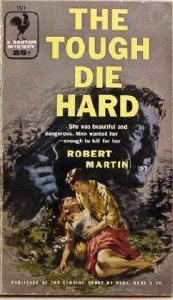 He did not fall prey to that somewhat epidemic fad among some writers who find it necessary to insert at least one word that is so archaic, so obscure, so obsolete and rarely used, that an abridged dictionary is useless in determining its meaning. Nor was he an author who scattered foreign language phrases without regard for his reader who may not be as adept with other languages. As I said earlier, when I was a kid, Robert Martin lived down the street from me in Tiffin, Ohio. When the leaves are off the trees his Victorian frame house is easily visible from my folks’ home. He had a daughter a few years ahead of me in school, a son two years behind me, and a second daughter younger still. One summer I mowed his next door neighbor’s very large yard (without benefit of a riding mower). I never met Robert Martin, I am positive, and I am fairly certain I never laid eyes on him. Maybe I had some awareness that a writer lived in town – it was not a secret – but it didn’t mean anything to me at the time. I left town in 1966 for college and moved back about twenty-five years later. Not too many people in Tiffin are left who knew him. There are some who knew of him, but most people have no idea who he was. Maybe he should have worked out a deal with Welcome Wagon to hand out copies of his paperbacks. Another person who never met Robert Martin is writer Bill Pronzini. After his own writing career was well under way, Bill wrote to Martin and Bob Martin replied, leading to a correspondence ending with Martin’s death in 1976. Pronzini recounted his relationship with Robert Martin in a column for Mystery Scene #41 many years ago. Pronzini included Robert Martin’s name in a list of favorite authors to whom he dedicated his novel Undercurrent. His most successful novel appears to have been Little Sister, a paperback original. It went through six U.S. printings. The “little sister” is a precocious bit of what is known in the vernacular as jailbait, the circumstances being a variation on The Big Sleep. As far as I know, this title did not appear as a British edition, although there are Canadian and Australian editions. Despite the successes he achieved as a writer, Robert Martin did have a day job, a responsible position as personnel director for a manufacturing company, as well as a wife and three children. Previously he was a bank teller. This work experience was a fruitful source of story material, but it also meant that writing could not be his highest priority. Though Martin’s output sounds impressive, no full-time writer could have survived on that kind of income. I have found several sources which either claim or at least suggest that Robert Martin lived in Cleveland (such as Bluebook for March 1954; Mercury Mystery Book Magazine for July, 1956; Bill Pronzini’s tribute mentioned above; and certain editions of the German paperbacks). My research in Tiffin, Ohio city directories and phone books shows him to have always lived here. The Tiffin factory where he worked was owned by Cleveland-based interests at times, so that may be the source of the residency claims. And it might have been much easier to tell strangers he was from Cleveland, a place people knew about, rather than Tiffin of a more select fame. Tiffin is about 60 miles southeast of Toledo, and about 30 miles from Lake Erie. One of Martin’s novels, Killer Among Us, centers around a factory 60 miles from Toledo. I am in the process of gathering information about Martin and his stories with the plan to “do something” to mark the centenary of Robert Martin’s birth in 2008. At the very least I will put up a display in the town library and perhaps in the local museum as well. A comprehensive bibliography would also be appropriate. Beyond that the possibilities are many and we’ll just have to see what can be accomplished. In the future I will examine some of stories in more detail and keep you informed of further developments. If there are any more Robert Martin/Lee Roberts fans out there, please make yourselves known. In the meantime, I urge you to read a Bob Martin story. Discover for yourself that he’s too good a writer to be forgotten. Series/Leading Characters, when known: AA = Anthony Abbott, PA = Pete Allen, JB= Jim Bennett, CC = Dr. Clint Colby, JD = John Deegan, LF = Lee Fiske, EG = Ellen Garry, RR = Rack Ramsey, R = Regent. 15 STORY DETECTIVE (Popular Publications) Killer on the Town, February 1950 Married to Murder, August 1950  ALL-STORY DETECTIVE (Popular Publications) Death’s Grinding Wheels, February 1949 Bullets for the Bride, April 1949 A Corpse in Time, October 1949 (LF) -reprinted in All Story Detective (UK) #4, 1950 BLACK MASK (Popular Publications) Rat Race in Foxtown, May 1946 Hanging is Too Good, March 1948 (JB) Let’s All Swing Together, March 1949 (CC) Death’s Glass Slipper, May 1949 (CC) Richest Man in the Graveyard, July 1949 (CC) Dirge in Bolero Time, January 1950 (CC) Lost in the Shrouds, July 1950 (CC) For Better or For Death, March 1951 (CC) BLUEBOOK (McCall’s) A Time of Evil, March 1954 DETECTIVE TALES (Popular Publications) Dead Center, April 1948 (JD) Deegan and the Deadly Dolls, May 1949 (JD) 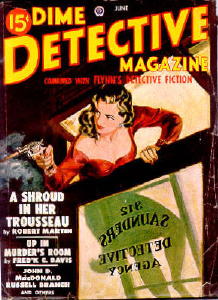 DIME DETECTIVE (Popular Publications) G. I. Doublecross, March 1945 (JB) Killers Can’t Be Careless, November 1946 (JB) Death Under Par, May 1947 Wake of the Willful Wife, August 1947 (JB) Death Gives a Permanent Wave, October 1947 (JB) Case of the Careless Caress, January 1948 (LF) Pardon My Poison, April 1948 (JB) No Haven for Homicide, May 1948 (EG) Dolls of Death, July 1948 (JB) Doctor of Doom, September 1948 She, Me and Murder, November 1948 (JB) -reprinted in Black Mask (UK), July 1950 Homicidal Honey, February 1949 (LF) Just a Corpse at Twilight, March 1949 (LF) Murder the Bum, April 1949 (JB) A Shroud in Her Trousseau, June 1949 (JB) Deadliest Dame in Town, September 1949 (JB) -reprinted as “Kuolema vietää viikonloppua,” 1954, Seikkailujen Maailma (The World of Adventure; Finland) Slayers Go Solo, November 1949 (JB) I’ll Be Killing You, February 1950 (JB) Sheathe Your Claws, Hellcat!, April 1950 (JB) -reprinted as “Kynnet piiloon, villikissa,” 1958, Seikkailujen Maailma (The World of Adventure; Finland) Murder on the Make, October 1950 (RR) -reprinted in Black Mask Detective (UK), March 1951 Slayers Burn Slow, November 1950 (JB) -reprinted in Black Mask Detective (UK), April 1951 Murder with Pleasure, February 1951 (R) Death Under Glass, February 1952 (LF) DOUBLE-ACTION GANG MAGAZINE (Columbia Publications) Midnight Call, April 1938 Getaway Doublecross, September 1938 -reprinted in Private Detective (Canada), February 1942 Gunsel, Get Ready to Die!, April 1939 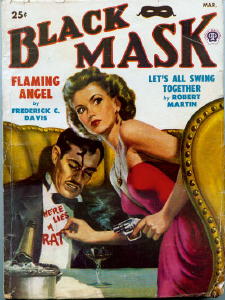 JUSTICE (Non-Pareil Publications) Husband's Best Friend, May 1955 (1#1) MAMMOTH DETECTIVE (Ziff-Davis Publications) Tea Party Frame Up, May 1944 (PA) Talk Yourself to Death, February 1947 (JB) Nothing But Trouble, April 1947 Passport to Murder, August 1947 MERCURY MYSTERY BOOK MAGAZINE (Mercury Publications) Catch a Killer, July 1956 (JB) NEW DETECTIVE MAGAZINE (Popular Publications) Remains – To Be Seen, November 1948 (JB) The House that Death Built, March 1950 (AA) SCARLET GANG SMASHERS (Associated Authors) A Case for the Morgue, May 1936 THRILLING DETECTIVE (Standard Publications) Murder Without Music, August 1945 (JB) Nice Like a Cobra, February 1947 Novels as by Robert Martin. Jim Bennett in all. Dark Dream, Dodd Mead, hc, 1951. Based on stories “Death Gives a Permanent Wave” and “Death Under Par,” Dime Detective. Pocket #913, pb, December 1952. Pocket #913, 2nd pr., 1954. Sleep, My Love, Dodd Mead, hc, 1953. Based on stories “Case of the Careless Caress” and “I’ll Be Killing You,” Dime Detective. Dell #794, pb, 1953. Tears for the Bride, Dodd Mead, hc, 1954. Based on stories “Killers Can’t Be Careless” and “Deadliest Dame in Town,” Dime Detective. Bantam #1372, pb, October 1955. The Widow and the Web, Dodd Mead, hc, 1954. Bantam #1397, pb, December 1955. The Echoing Shore, Dodd Mead, hc, 1955. Bantam #1577, 1957, as The Tough Die Hard. Just a Corpse at Twilight, Dodd Mead, hc, 1955. Catch a Killer, Dodd Mead, hc, 1956. Based on story “Hanging Is Too Good,” Black Mask. Abridged version, Mercury Mystery Book Magazine. 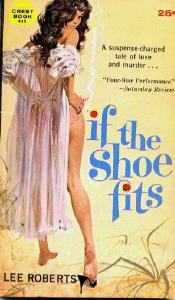 Hand-Picked for Murder, Dodd Mead, hc, 1957. Based on story “Remains – to Be Seen,” New Detective. Killer Among Us, Dodd Mead, hc, 1958. Detective Book Club, hc, 3-in-1 edition, February 1959. A Key to the Morgue, Dodd Mead, hc, 1959. Detective Book Club, hc, 3-in-1 edition, September 1959. Ace Double D-451, 1960. [Paired with STEVE WARD Odds Against Linda.] To Have and To Kill, Dodd Mead, hc, 1960. Based on story “A Shroud in Her Trousseau,” Dime Detective. Ace Double F-111, 1961, abridged. [Paired with J. M. FLYNN The Girl from Vegas.] She, Me and Murder, Hale-UK, hc, 1962. Based on story “She, Me and Murder,” Dime Detective. Curtis 07162, pb, 1971. A Coffin for Two, Hale-UK, hc, 1962. Based on story “Death Under Glass,” Dime Detective. Curtis 07170, pb, 1972. Bargain for Death, Hale-UK, hc, 1964. Curtis 07183, pb, 1972. Novels as by Lee Roberts. pbo = paperback original Leading/Series Character: AB = Andrew H. Brice, LF = Lee Fiske, CP = Chad Proctor, RR = Rack Ramsey, CS = Dr. Clinton Shannon. 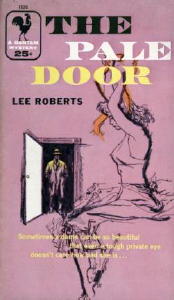 Little Sister, Gold Medal #229, pbo, March 1952. (AB) Based on story “Pardon My Poison,” Dime Detective. Gold Medal #229, 2nd pr., 1953. Gold Medal #565, 3rd pr., 1956. Gold Medal #565, 4th pr., 1957. Gold Medal #934, 5th pr., 1959. The Pale Door, Dodd Mead, hc, 1955. (CP) Detective Book Club, hc, 3-in-1 edition, February 1955. Bantam #1535, pb, November 1956. Judas Journey, Dodd Mead, hc, 1956. (RR) Based on story “Murder on the Make,” Dime Detective. Popular Library Eagle EB-50, pb, January 1957. The Case of the Missing Lovers, Dodd Mead, hc, 1957. (LF) Once a Widow, Dodd Mead, hc, 1957. (CS) Detective Book Club, hc, 3-in-1 edition, November 1957. Dell #1003, pb, July 1959. If the Shoe Fits, Dodd Mead, hc, 1959. (CS) Crest #415, pb, November 1960. Death of a Ladies’ Man, Gold Medal #968, pbo, February 1960. (CS) Suspicion, Hale-UK, hc, 1964. (CS) Curtis, pb, 1971. _____ 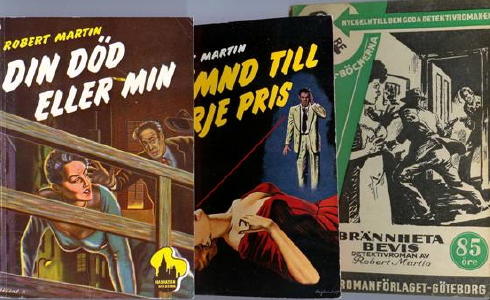 Pulp cover images courtesy of Phil Stephensen-Payne, whose Galactic Central website dedicated to Fiction Magazines of all varieties continues to grow and grow. Editorial Postscript: Of Robert Martin’s novels, the most difficult to locate may be Suspicion, written as by Lee Roberts. When an ABE search was conducted in mid-March, no copies of either the British hardcover or the US paperback were to be found. Equally difficult to obtain is Hand-Picked for Murder. A search on ABE two years ago resulted in only one copy of the hardcover. The one that was available was in jacket, in VG/VG condition, and the asking price was a mere $145.00. It is now no longer there, and no other copy has replaced it. Jim Bennett, the creation of writer Robert Martin, is a direct descendent of the ops created by Hammett and Chandler. Like these ops, Bennett carries himself with a stoic coolness. Despite being hit on the head numerous times or being shot more than once, it takes a lot to rile up Bennett. However, when angered, he can be a violent man. Yet in a quiet sort of way he empathizes with many of the characters he meets. He claims throughout the series to be “almost forty,” and once he establishes a romantic relationship with his secretary Sandy Hollis, they never consummate their relationship or actually marry despite a long courtship. However, this does not keep him from kissing any woman he feels like. Martin makes an attempt to create real puzzles for his detective to solve. Some of his novels appear to be modeled on the classic detective novels that originated during the Golden Age. Oddly, he manages to create dark and dangerous places for his detective to solve crimes in, yet he rarely uses the Cleveland area that is Jim’s hometown. Instead, we get a small town noir series in the thirteen books, often set in an industrial setting perfect for noirish, hard-boiled tales. The industrial settings may ring so true because Martin worked in an industrial setting and evidently wrote what he knew. ROBERT MARTIN Without trying to duplicate the information provided by Jim Felton in his profile of Robert Martin which appeared above, here is what I found out about him in the mid-1960s entry in Contemporary Authors and what was said about him in his obituary: Robert Martin was born on October 16, 1908, in Chula, Virginia, to Joseph and Harriet (Repasz) Martin. Martin graduated from Columbian High School in 1927 located in Tiffin, Ohio. It is not clear if he had any other formal education. My sources say no, but it is Jim Felton’s understanding that he graduated from college in 1930. Martin was a bank teller for the First National Bank of Tiffin from 1928 until 1934. He became a stock clerk at the Sterling Grinding Wheel Company in Tiffin in 1934. Martin was their stock department manager from 1936 to 1941, and an assistant in the personnel department from 1941 to 1945. He married Alverta Mae Smith in 1942, and they eventually had two daughters and one son. Martin became the assistant personnel manager from 1945 to 1950 and then the personnel manager. He enjoyed shooting, fishing and golfing. He died in Tiffin on February 1, 1976. 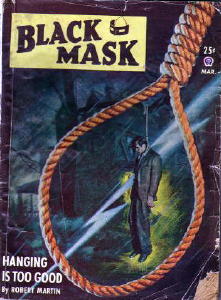 JIM BENNETT James “Jim” Tobias Bennett was born in a small town in approximately 1913. He spent the last two years of his high school career in Cleveland where he attended school with Helen Connors, Kay Starr and Don Canfield, characters from Sleep, My Love. He played high school football. He served in World War II and had the rank of second lieutenant. He once worked as an auto mechanic. Sixteen years prior to Dark Dream (approximately 1935), Jim had dropped out of college after studying law for two years. In later books, Jim refers to being “just out of law school” and claims in To Have and to Kill to be a lawyer and a member of the state bar association. In last book in the series, Bargain for Death, he tells us he practiced law in Youngstown after he graduated from the Ohio State School of Law and that he worked for one year for a law firm in New York. Jim then joined the National Detective Agency. For some unknown reason, in Hand-Picked for Murder it is called the American Detective Agency. By the time of A Key to the Morgue, the name of the agency is American-International. The National Detective Agency is a firm often referred to as being the private equivalent of the F.B.I. His boss in New York is always referred to as the old man. The old man owns 65% of the stock in the company and rules from afar with a reputation for being greedy. Jim went to the National Detective Agency’s training school. He worked out of the New York office just after his training. By Dark Dream, Jim is the chief district agent for the Cleveland branch and owns some stock in the company. The sixth-floor office has a private backdoor entrance that allows Jim to enter without being seen by his clients. Jim’s secretary at the Cleveland branch is Sandy Hollis. Sandy is a long-legged woman with brown hair (later she has copper colored hair) and brown eyes. In Tears for the Bride, she has been with the agency for two years. She is waiting for a boyfriend who is a test pilot missing on a flight over the Pacific, but Jim kisses Sandy for the first time on this case. In Killer Among Us, Jim proposes to Sandy while they are staying in a motel in Maple Hill, Ohio. By a Coffin for Two, Sandy has a diamond engagement ring. For most of the books in the series, Jim is waiting for Sandy to pick a date for their wedding. However, this does not keep him from kissing other women with great regularity, and he almost sleeps with another woman in the last book in the series. Alec Hammond is Jim’s full time assistant in the Cleveland branch. He is tall, lean man with red hair, freckled face and greenish eyes. In The Widow and the Web, Alec becomes the acting manager of the Cleveland branch when the big boss in New York transfers Jim to other work. Red Drake is a part time operative for the Cleveland branch. In Sleep, My Love, Jim also uses an op named Homer Shippen. In Just a Corpse at Twilight, Jim also has a part time op named George. In Tears for the Bride, there is an unnamed part time office girl on the staff. In Bargain for Death, he mentions having three full time helpers besides Sandy, Alec and Red. Jim’s police contact in Cleveland is Detective Sergeant Dennis Rockingham, who later is promoted to Lieutenant. Jim has black hair parted on the side and it always needs to be trimmed. He has blue eyes and weighs 190 lbs. He has a scar on his chin from when a man tried to kill him in Youngstown, Ohio prior to the start of the series. Jim is a constant drinker, but seldom seems drunk. Jim is a smoker. Jim plays golf and is a trout fisherman. He reads westerns. Jim lives in Apartment D on the fourth floor in a building in Cleveland. His neighbor across the hall is Oswald McKinney, an investigator for the I.R.S. Jim has a friend named Skip Gordon who is a Cleveland sports writer. In Sleep, My Love, he describes himself as “pushing 40” (actually he is 40). In Hand-Picked for Murder, he is “almost 40” (actually he is 44) as he is in Killer Among Us (actually he is 45). By a Key to the Morgue, he would be 46, but still says he is “almost 40.” Two months prior to Dark Dream, Jim solved the murder of Alvin T. Bayne, a Cleveland businessman in a case we only hear about. Jim carries a Smith & Wesson .38 as his favorite piece and he also has a .32 automatic. Jim drives a coupé. He claims to be a card-carrying member of the Beaver Lodge of Cleveland. In Dark Dream, the Jim’s agency fee is $50 per day plus expenses (he accepts $100 a day plus expenses in She, Me and Murder). Jim kills a man on the Dark Dream case. He will kill again. 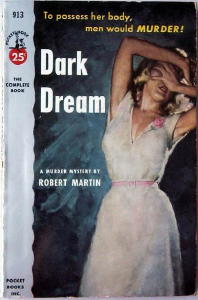 DARK DREAM (Dodd, 1951) begins out on the golf course at the Wheatville, Ohio, Country Club, where someone has been taking pot shots at lawyer Sam Allgood. He hires Jim to find out why. Jim discovers that Margaret Roark is challenging Sam’s wife Katherine for the County Club female golf championship. Margaret is the daughter of Red Roark, a small-time professional golfer who died one year prior on the same day Red supposedly threw a golf match against the legendary Alabama Kid. Margaret works at Armand’s Beauty Salon whose owner, Pete Donati, wants to hire Bennett to discover who has been tampering with his equipment and harming his customers, a case which gets complicated quickly by murder. Meanwhile, Sam is having an affair with Lily Winters, wife of his law partner Jeff. Sam also connects to one of the major players in the beauty shop murder case, and Jim tries to work both cases simultaneously. A great deal of the book contrasts the sordid affairs of some of Wheatville’s residents with Jim’s romantic love for a former beauty now scarred horribly after an auto accident. Definitely in the Hammett-Chandler school of writing, this tale manages to pull it all off in a neat little package at the end. The somber, stoic Jim Bennett makes an interesting character to follow. Recommended.  In SLEEP, MY LOVE (Dodd, 1953), Jim is the witness to the slow descent of his high school pal Don Canfield. First, Don does not get the promotion he wanted at Connor Electric in Cleveland. Don’s wife Kay divorces him, separating Don from his daughter Annie. Then, his boss Roger Quinn introduces Don to a floozy named Louette and a quick marriage follows. But one day after Don catches Louette with another man, Jim and Don discover Louette’s dead body in the couple’s apartment. Before Jim can offer much help to his friend Don, he gets a panicky call from Roger Quinn. In a ratty hotel in East Grange, Ohio, lies the dead body of Melissa, one of Roger’s many extramarital affairs. Consequences for these crimes fall on one character, and there are tragic results. Martin makes us care about these characters because he is adept at creating their little worlds. He makes each one fallible, yet fully aware of their defects to the point where some accept the reasons for their eventual downfall. Although Jim may be a bit stoic, cold and hard to get close to – “I’m nobody’s lover” – Jim is not afraid to accuse anyone, even someone he develops some feelings for. There are too many deaths to explain in this particular book to overly praise this title, but up until the explanation of the murders it satisfied me. Recommended. Sleep, My Love takes place in May.
On this
case, Jim is driving an agency Ford that is one of two vehicles
available to him. Tears for the Bride takes place in November,
which is two years after Dark Dream. Jim is now driving a
one-year old Mercury. Jim also kills a man and is shot
himself in the stomach area.
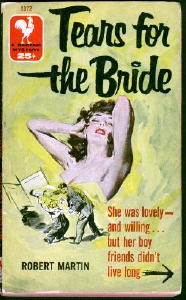 In TEARS FOR THE BRIDE (Dodd, 1954), Jim is invited to a farm near Ridge City, Ohio, where his secretary Sandy Hollis’s family is gathering. Sandy’s brother Ralph is engaged to Eileen Fortune after Ralph dumped Judy Kirkland. Besides Judy sulking around Ralph, Earl Seltzman is reeking ill will because he loves the now spoken-for Eileen. While part of a hunting party, Ralph is accidentally shot by Judy. With everyone carrying a gun and bad attitudes, it is surprising when the first actual dead body is the kindly caretaker of the family farm, Rex Bishop. Bennett has to take the investigation personally when someone shoots at him, but also because he kisses his secretary Sandy for the first time. Although attractive to women, he maintains his distance for people, as when his reaction to leaving a sexually desperate widow alone is “it was men like me who were responsible for women like Daisy Browns.” There is an economy to this novel best summed up by Bennett himself when he states “people got shot at and women made passes and the liquor flowed and nothing added up.” There is an economy in the explanation as well, making this rural crime story highly recommended.
The Widow and
the Web takes place in April, 1954,
six months after Tears for the
Bride. Jim has been transferred
from Cleveland by the old man in
New York. He is now working for the Industrial Welfare
Commission’s Department of Investigations, in a mid-southern state, on
a trial basis for three months doing industrial safety and accident
investigations. He is living in the Blue Ridge Hotel in Steel
City which is four hundred miles from Cleveland. While working
for the Commission he picks up a partner in Al Purdy. Al has a
wife named Annabelle and two kids.
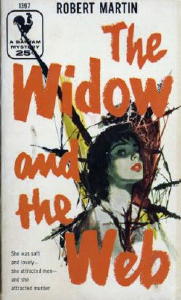 On a routine assignment to verify the facts in the case of George Shannon, who fell from a ladder at the Ferris Abrasives plant in Steel City, Jim receives an anonymous note claiming Shannon’s death was murder. In THE WIDOW AND THE WEB (Dodd, 1954), Jim finds himself yanked “back again in the world where people deliberately hurt other people, in one way or another, and I hated it.” Jim presses on when everyone else tells him to give the investigation up until one key witness is murdered. As always in these Martin novels, there are a number of fully developed female characters all of whom are damaged seriously by the consequences of their lives or the loss of someone important. While Jim may occasionally kiss one of the women, he still remains a cold lover who understands his own shortcomings. After thinking poorly of one of the women, Jim thinks “maybe she wasn’t so bad, after all. Maybe it was me.” When it comes to stopping a criminal, however, he has deductive skills worthy of any detective. There is a melancholy acceptance of the irony of crime here when Jim says, “people did the things they had to do, because of one desperate compulsion or another, and that was the way it went into the record.” Although the plot in this book would fill a short story, Martin executes it with characters that reverberate with honesty and therefore I can still recommend this title. JUST A CORPSE AT TWILIGHT (Dodd, 1955) takes place in June, 1955. Jim says he has been working for the Commission for nine months (but by my count it would be 14). Jim mentions his annual salary is $8,300. He is in Beach Tree investigating the death of Frank Osborn. Frank had a serious case of silicosis, a lung disease, but the cause of his death was ruled a heart attack by attending physician and coroner Dr. Dick Jarrett. When Frank’s widow Alice is shot to stop the autopsy that Jim wants done on Frank’s body, Jim discovers two prominent Beech Tree citizens were wooing the widow before her death. The battle settles down to contest between Jim and the local sheriff Abner Cornwallis. The central question becomes: why does everyone in this small town opposes the exhumation of Frank’s body? Martin attempts to make this struggle epic, but ultimately it lacks power and remains slightly undramatic and unemotional in the telling. Because of that, I can only rate this title average. CATCH A KILLER (Dodd, 1956) begins with Martin reprising the opening of Raymond Chandler’s The Big Sleep by having Jim visit the widow Lavina Hopkins in her Cleveland sunroom on a hot August day. There he hears of Francine, Lavina’s young daughter, who years earlier had run off with trumpeter Johnny Wingate. When Jim tracks Francine down in Columbus, it is just as she is about to be reunited after a two year split with the trumpeter who is now a national sensation. With a marriage planned, Francine is breaking the hearts of three different Columbus residents. Francine is also not interested in her mother’s will that requires her to return to Cleveland in order to inherit. When Johnny is murdered during a break in a concert held in Columbus, Jim finds himself aiding the local police in a murder investigation. While Martin will never be mistaken for Agatha Christie, he has developed a play-fair style that does a good job of creating suspects in his mysteries. Here, as always, his characters are well drawn but the plot becomes pretty obvious as it develops. I can only rate this one average. HAND-PICKED FOR MURDER (Dodd, 1957) takes place in August. Jim is shot in the shoulder on this case. It begins with a creaky old plot device: Hugo Howell’s son Wayne will inherit $200,000 if he is married by the age of twenty-five. Otherwise, Wayne must split the money with his father. Hired by Hugo to break up the relationship between Wayne and Sandra Osterman, Jim finds he does not trust Hugo because he so desperate for the money. He also discovers Wayne and Sandra are already married. End of creaky plot device. Hugo, being an alcoholic and cut off from any money, begins to irritate everyone in the small resort town of Lakeport. Eventually, someone tries to kill Hugo with an ice pick, only to stab the wrong man. Hugo is one of the more maniacal characters created by Martin, and he is extremely well drawn. The story is set in a well-developed small town setting (including the resort area of Catawba Island), and the resolution is wonderfully done in a Golden Age sort of style. Thematically, this is not a great novel, but it packs enough play-fair structure to be recommended as a good mystery. For seventy-five years, Buckeye Abrasives has manufactured quality grinding wheels for Ohio industries from its plant in Maple Hill. But recently, a series of faulty parts have failed, and finally one broke during operations at the Portage Foundry in Toledo. A man is dead because of it in KILLER AMONG US (Dodd, 1958). Jim is hired to come into the Buckeye plant as an undercover op, and he is on the spot when a wheel explodes and injures Howard Ackerman, a Buckeye plant executive. Sorting through a multitude of potential suspects, each with a definitive and well-defined reason for committing industrial espionage, Jim discovers a series of clues that eventually are able to provide a play-fair conclusion for the reader who likes details in their mysteries. As a reader, I am more interested in the big swatches and this book has them. What better setting for the hard-boiled detective than a blue-collar environment like an abrasives plant. The men who dwell there and the women affected by it are well drawn, especially in regards the effects of their wayward affections, the dangerous work they do, and their desire for money and advancement. Jim kills a man but he is also grazed by a bullet in his side. The painful and evocative bittersweet final pages of this novel only helped me in regarding this as a classic in the P. I. field. In A Key to the Morgue (Dodd, 1958), Jim claims to be a member
of a
Cleveland area country club. It is September and he is driving a
two year old Mercury that belongs to the agency. Jim now claims
to have in his arsenal a .12 gauge shotgun, a Springfield 30-06 rifle
and a Harrington & Richardson nine shot .22 revolver. He
kills two men on this case, and at the end of it the “old man” in New
York offers him the opportunity to succeed to the head when the old man
retires. Jim’s cop pal Rockingham has received a promotion to
Lieutenant.
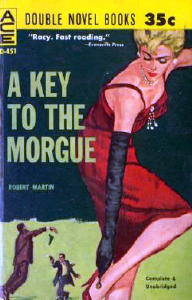 Alvin Bayne came into money through the produce business but his blue-collar background makes him uncomfortable at the Cleveland country club where he plays golf with Jim. He is also made uncomfortable by his wife, the former dancer Arlene Aragon. Then, he is made dead, shot in his own home while he was shaving in A KEY TO THE MORGUE (Dodd, 1959) Jim is incensed by Alvin’s death, and his anger grows when two hoods molest Sandy while trying to get to him. Jim knows that Alvin was about to change his will (gasp – not that old ploy!) so he hooks up with Alvin’s lawyer Orville Hewing to launch a private and personal investigation. Then a shocking revelation about Alvin’s post-divorce plans rock Jim’s perceptions, yet he plunges on. This is by far the darkest, most violent of all the cases so far. Risking his license and his reputation, Jim rolls from one killing to the next trying to clear his friend’s name and eventually his own. Hard-boiled to the maximum, this cold and bleak tale is highly recommended. Maxwell Daney manages to run a soda pop industry, but he cannot manage his own love life in TO HAVE AND TO KILL (Dodd, 1960). On a July weekend, he has asked Jim and Sandy to be in his wedding party when he marries Laura Reynolds. That same weekend, Dixie McQueen invades his Lake Erie shoreline mansion. Dixie is from Chicago and has arrived under the impression that she is to meet Max’s mother Augusta and possibly qualify to be Max’s intended. With two women vying for the same man, a jealous Mom in the house, and one of the women’s jilted lover on the scene, it should surprise no one that Jim finds a dead woman on the beach one night. This one is structured like the Golden Age house party novels, with everyone isolated at the mansion making just enough suspects for a clue driven puzzler. There are clues here, and they work for the benefit of the plot, but the plot itself is too messed up with the inclusion of two deaf mutes and their bizarre story. Yet, it was satisfactory in a traditional mystery sort-of-way, with less of the hard-boiled sensibilities evident in the last two novels in this series. Recommended mostly for its puzzle format, this title does little to advance the series. A COFFIN FOR TWO (Hale (Brit), 1962; US: Curtis, 1972) opens with a big coincidence. On a June summer night, Jim accompanies his reporter friend Jake Camp to a Beech Fork cemetery to visit the newly discovered family vault of the Keeting family. Jake had discovered the long forgotten vault while hunting for arrowheads, but both men are at the vault when distant relative Nancy Keeting arrives with the intent to mover her relatives from this discarded vault into the real cemetery that lies a few short yards away. But that is not the big coincidence. Jim then returns to Cleveland only to be hired by Emily DeWitt to find her missing husband, First Union National bank president Earl DeWitt. Earl was last seen in Beech Fork at a cemetery association meeting with cemetery custodian Sam Green. Coincidence? You bet! However, eventually the oddity fades away in an amalgam of suspicion and misbehavior in the small town of Beech Fork, including a sheriff who could get a job in Raymond Chandler’s Bay City if he needed one. Here is another book by Martin full of flawed characters in a small town noirish setting. Not his best effort but still a title recommended for fans of the hard-boiled style. 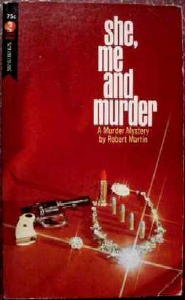 It is November, and Atlantis Productions in Los Angeles is going to make a film about the old man who is boss of American-International in SHE, ME AND MURDER (Hale (Brit), 1962; US: Curtis, 1971). All of the P.I. offices are to send copies of their files to the film studio for the writers to produce the script. This worries former theatrical agent Enos Weber because he had asked Jim to investigate Enos’ wife for a divorce proceeding. Jim had refused the case, and handed it off to Cleveland P.I. Jake Doan. Doan had copied Jim with the file, and now Enos wants it. The divorce was called off when Enos was able to use Doan’s evidence to blackmail Atlantis president Hiram Wyndham and land a cushy job with Atlantis in Hollywood. Now Enos’ sweet deal is threatened if the files are opened. Meanwhile, the actress Tracy Kent, with whom Enos had an affair of his own, is in Cleveland and causing trouble. She is sleeping with the young actor Peter Ordway while being stalked by her sugar daddy, Harold McPherson. Then Ordway is dead, Sandy is kidnapped, and Jim goes into a rampage of hard-boiled action. As the case evolves, the sordid motivations of the major players are revealed and no one comes out looking very good. The strength of the characters created by Martin carries this novel, set in seedy bars, roadside eateries and lonely-hearts hotels. I can recommend this title more for its style and less for its rather odd plot.
In She, Me and Murder, Jim
says he has been with the agency twenty
years. He claims “I’m not a joiner” in denying joining any
organizations, forgetting that he is a Beaver Lodge member and plays
golf as a member of a country club.
The final case in the series, BARGAIN FOR DEATH (Hale (Brit), 1964; US: Curtis, 1972), takes place in July. Walter Larkin has big union negotiations upcoming at his plant in Central City when his wife Meg forces him to hire her wayward brother Peter Clovis as a plant negotiator. Jim is an old family friend, and Walter has hired him because of two problems at the plant. Jim manages to solve both of Maxim Products problems only to hand them an even bigger one when he belts the union negotiator during the talks. The plant goes on strike, and someone takes a shot at Jim. Unfortunately, on top of being dumb enough to lose his temper and hit someone, Jim leaves the scene of the shooting without talking to the cops. His renegade style in this novel is not help by some continuity problems within the plot. Characters, normally a strong suit for Martin, act like fools here, and the novel reads with a regrettable sense of confusion and disbelief, which is too bad for a series that has had few stumbles. Martin is preachy on the issue of unions and management, which may have sidetracked him from writing this one as it should have been. I would rank this one only average. These articles and accompanying checklist first appeared in Mystery*File 43, April 2004. UPDATE: For a companion piece on Robert Martin, in which Bill Pronzini writes about the correspondence he had with him shortly before his (Martin’s) death, go here. Many more jacket covers are included. YOUR COMMENTS ARE WELCOME.
Copyright © 2004 by Steve
Lewis. All rights reserved to contributors.
Return to
the Main Page.
|